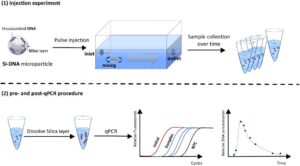Using novel environmental tracers to test the effectiveness of Natural Flood Management interventions
Introduction
Natural Flood Management (NFM) techniques are being implemented throughout the UK in response to the increasing frequency and magnitude of flood events. NFM interventions include: reconnection of floodplains, changes in land use management, adding runoff attenuation features and in-channel modifications. These all seek to manage the sources and pathways of flood waters to delay, reduce or alter the flood pulse in a way which reduces the flood hazard. NFM is often focused in upland rural catchments to limit local flood hazards in addition to providing protection to larger downstream urban populations. Despite the increase of NFM schemes by public and private bodies, our understanding of the effectiveness of these interventions in mitigating flood impacts is limited due to difficulties in determining rainfall flowpaths through the catchment. Without this understanding, it is difficult to determine the extent to which NFM interventions contribute to decreased flood risk, and the scale of any benefits NFM might impart. This lack of evidence further limits the uptake and design of new NFM interventions, and may even mask the potential for NFM measures to increase flood risk in some situations and locations due to floodwater synchronisation1.

Figure 1: Detail of tracer productino and analysis used by Mikutus et al.5 , which utilised silica encapsulated DNA tracers to characterise aquifer properties.
Environmental tracers have long been used to assess hydrological flow paths in catchments, providing information on the source, route and residence time of water2. However the use of environmental tracers such as isotopes and solutes are often constrained by local conditions, such as the geology and land use, which limit where each technique can be employed3. Recent advances in the use of artificial tracers, including eDNA techniques have shown that artificial tracers had better stability and recovery than traditional natural tracers4 allowing these to be applied in a wider range of temporal and spatial scales (Figure 1).
Encapsulated DNA microparticles in particular have been shown to be traceable at greater distances and at a lower concentration than more traditional solute tracers4. Silica is a common mineral found in sands and silts that make up the sediment load in many natural waters. Silica particles can be easily synthesised in the lab from aqueous solution using cheap and non-toxic precursors. Their size can be tuned and controlled, their surface functionality is easily modified, and they can be incorporated with a range of different fluorescent, isotopic or organic labels (such as DNA). These properties make silica particles excellent substrates for making bespoke, multifunctional, tuneable and barcode-able tracer particles for studying fluid flow in natural water systems.
Project goals
This studentship will pioneer the use of eDNA to assess NFM interventions by providing initial exploratory data and analysis on the feasibility and protocol of the technique. The student will be instrumental in identifying and introducing silica encapsulated DNA microparticle tracers into an upland Pennine catchment to track rainfall runoff. Laboratory based methods to identify a suitable eDNA tracer will be completed, followed by high-frequency field sampling in catchments where NFM measures have been introduced. These data will subsequently be used to provide the evidence required to ascertain the timing and magnitude of peak flood flows from different NFM interventions and tributaries. Coupling of experimental and observational data using novel tracer techniques in this manner will allow, for the first time, significant new insights into the potential for NFM techniques in managing flood risk in the UK and world-wide.
Benefits
The successful candidate will benefit from inter-disciplinary training in hydrology in the School of Geography, and tracer synthesis and quantification with the School of Chemistry and School of Molecular and Cellular Biology. DNA laboratory techniques will be learnt in collaboration with project collaborators and colloid tracer manufacturing with the School of Chemistry. The nature of the project means that the student will be trained via informal internal training (e.g. qPCR methods, hydrological sampling) and external training programs and workshops (e.g. DNA laboratory methods and hydrological modelling). An additional important part of the training will be to attend a national conference to present results and gain feedback. The student will be encouraged to submit a high quality paper for publication during the project, and will be supported in this process.
